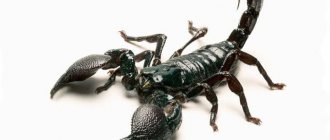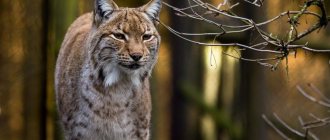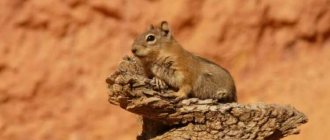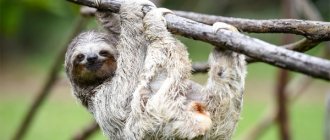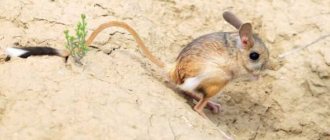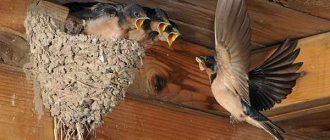- Wild animals
- >>
- Arachnids
The emperor scorpion is one of the most famous species and also one of the largest in the world. This is one of the oldest creatures that has survived to this day. Scorpios have lived on planet Earth for almost 300 million years, and over these many years they have not changed much. You can observe them in their natural environment only at night. There are more than a thousand species of scorpions, all of them are poisonous to one degree or another, but only about twenty of them have a fatal bite.
Origin of the species and description
Photo: Imperial Scorpion
The emperor scorpion (Pandinus imperator) is the largest species of scorpion in the world. Its length on average is about 20-21 cm, and its weight is 30 g. Pregnant women are much larger and heavier than their relatives. However, some species of forest scorpions are quite similar in size, and the scorpion Heterometrus swammerdami holds the world record among fellow scorpions in length (23 cm). Animals grow quickly. Their life cycle is a maximum of 8 years. They reach full maturity after 5-6 years (adult size).
Historical reference! The genus was first described by C. L. Koch in 1842. Later in 1876, Tamerlan Thorell described and recognized it as his own genus discovered by him.
Then the genus was divided into five subgenera, but the division into subgenera is now in question. Other common names by which the animal is known are the Black Imperial Scorpion and the African Imperial Scorpion.
Video: Imperial Scorpion
The common ancestor of all arachnids probably resembled the now extinct eurypterids or sea scorpions, fearsome aquatic predators that lived approximately 350-550 million years ago. Using their example, it is easy to trace the evolutionary movement from an aquatic existence to a land way of life. Eurypterids, who lived in the water element and had gills, had many similar features to modern scorpions. Land species similar to modern scorpions existed in the Carboniferous period.
Scorpions have occupied a special place in the history of mankind. They are part of the mythology of many peoples. Representatives of the genus are mentioned in the “Book of the Dead” in Egypt, the Koran, and the Bible. The animal was considered sacred by the goddess Selket, one of the daughters of Ra, the patroness of the world of the dead.
Uroplectes lineatus
The habitat of the small fat-tailed scorpion is the desert expanses of the southeastern tip of Africa. This type of scorpion makes the first threatening and striking impression with its unusual color.
Its back, claws and the tip of its tail are black, but its limbs and part of its tail are red. The bite of such a “handsome one” is quite painful and causes discomfort.
In people with weakened immune systems, a bite can cause fever and prolonged allergic reactions.
8
Appearance and features
Photo: Tropical Photo: imperial scorpion
The imperial scorpion is dark blue or bright black in color interspersed with brown in some areas and a grainy texture. The sides of the body have a whitish stripe that extends from the head to the tail. The tip of which is known as the telson and has an intense red color, contrasting with the entire anatomy of the animal.
After molting, these scorpions acquire a golden color from tail to head, which gradually darkens until the intense black color is the usual coloring of adults.
Fun fact! Emperor scorpions fluoresce under ultraviolet light. They appear bluish-green, which allows people and other animals to detect them and take precautions.
Adult scorpions are difficult to distinguish, as males and females look alike. Their exoskeleton is very sclerotic. The front part of the body, or prosoma, consists of four parts, each with a pair of legs. Behind the fourth pair of legs are ridge-like structures known as pectins, which tend to be longer in males than in females. The tail, known as the metasoma, is long and curves backward throughout the body. It ends in a large vessel with poisonous glands and a pointed, curved sting.
The emperor scorpion can move very quickly over short distances. When moving long distances, he takes many breaks to rest. Like many Scorpios, he has very little stamina during his active phases. It is nocturnal and does not leave its hiding places during the day.
Structure
The scorpion's body has a small cephalothorax (prosoma) and a long abdomen (opisthosoma). The abdomen itself is divided into 2 sections:
- In front there is a wide section, closely connected with the cephalothorax. Together they are called the preabdomen.
- At the back there is a narrowed five-membered section, which is called the post-abdomen. This part of the body is similar to the tail.
Adjacent to the fifth segment of the narrow section of the abdomen is an additional pear-shaped segment. Its name is telson. This is a tail spike with a needle bent upward, on top of which there are poisonous glands. As you understand, this creature does not bite, but stings its prey. The question immediately arises: “Is the emperor scorpion poisonous or not?” There's no need to worry. The poison of this species has no effect on humans. Although it can cause a severe allergic reaction.
The scorpion's body is “packed” into a chitinous shell, consisting of several scutes and closed rings. The front pair of limbs, chelicerae, are horizontal claws similar to mandibles. They are located above the mouth opening. The next pair of limbs are called pedipalps. They also have claws, but much larger ones, designed for holding and tearing food. Scorpions have 8 walking legs.
The imperial scorpion breathes through pulmonary sacs. The animal has a good sense of touch, but poor vision. The eyes are located on the cephalothorax: a pair of large ones in the middle and 5 pairs of small ones on the lateral surfaces.
Where does the imperial scorpion live?
Photo: Black Imperial Scorpion
The emperor scorpion is an African species native to tropical rain forests, but is also present in the savanna, in close proximity to termite mounds.
Its location has been recorded in a number of African countries, including:
- Benin (small population in the western part of the country);
- Burkana Faso (very common, almost everywhere);
- Ivory Coast (quite common, especially in hard-to-reach areas);
- Gambia (is far from being in the first positions among the Scorpio representatives of this country);
- Ghana (most individuals are located in the western part of the country);
- Guinea (widespread);
- Guinea-Bissau (found in small quantities);
- Togo (revered by local residents as a deity);
- Liberia (found in the wet shrouds of the western and central parts);
- Mali (the emperor scorpion population is widespread throughout most of the country);
- Nigeria (a common species among representatives of the local fauna);
- Senegal (small numbers present);
- Sierra Leone (large colonies are observed in the eastern tropical forests);
- Cameroon (quite common among fauna).
The emperor scorpion lives in deep underground tunnels, under rocks, broken branches and other forest debris, and in termite mounds. Pectins are sensory organs that help determine the area where they are located. The species prefers relative humidity of 70-80%. The most comfortable daytime temperature for them is 26-28 °C, and at night from 20 to 25 °C.
Hottentotta Tamulus
Already from the name “red Indian scorpion” it is clear that this species lives in India, and can also be found in neighboring Pakistan and Nepal.
Like many representatives of the species, Buthidae usually lives under the bark of trees, but there are often cases when it settles in wooden dwellings of people or outbuildings for livestock. It was discovered in 1798, and after observations it was established that it grows no more than 9 cm.
The bite is fatal to humans, and 40 out of 100 cases are fatal. The toxic poison is especially dangerous for an unformed child’s body, as well as for people suffering from heart disease.
1
What does the emperor scorpion eat?
Photo: Imperial Scorpion
In the wild, emperor scorpions primarily consume insects such as crickets and other terrestrial invertebrates, but termites make up the majority of their diet. Larger vertebrates such as rodents and lizards are less commonly eaten.
Emperor scorpions hide near termite mounds up to 180 cm deep to hunt prey. Their large claws are designed to tear apart prey, and their tail stinger injects venom to help liquefy food. Juvenile scorpions rely on their venomous sting to paralyze prey, while adult scorpions rely more on their large claws.
Curious! Sensitive hairs covering the pincers and tail allow the emperor scorpion to detect prey through vibrations in the air and on the ground.
Preferring night time for walking, the emperor scorpion can be active during the day if the light level is low. The imperial scorpion is a champion in post. He can live up to a year without food. One single moth will satisfy him for a whole month.
Despite the fact that it is a huge scorpion with a menacing appearance, its venom is not fatal to humans. The venom of the African emperor scorpion is mild and moderately toxic. It contains toxins such as imperatoxin and pandinotoxin.
Scorpion stings can be classified as mild but painful (similar to bee stings). Most people do not suffer from an emperor scorpion sting, although some may be allergic. Various ion channel toxins have been isolated from emperor scorpion venom, including Pi1, Pi2, Pi3, Pi4 and Pi7.
Androctonus crassicauda
The name of this inhabitant of the Arabian deserts literally translates as “killer of men,” and it can be found in some regions of Turkey, Iran and Saudi Arabia. Some subspecies of one of the most dangerous scorpions on the planet also live in Africa.
They grow up to 10 cm, and the poison contains an extremely toxic neurotoxin that can cause harm to health and even cause death.
In addition, the Arabian fat-tailed scorpion has a terrifying black color and is distinguished by aggressive behavior, so you must be extremely careful when in its habitat.
3
Features of character and lifestyle
Photo: Animal imperial scorpion
This species is one of the few scorpions that can communicate in groups. Animals exhibit subsociality: females and offspring often live together. The imperial scorpion is not aggressive and does not attack its relatives. However, food shortages sometimes lead to cannibalism.
Emperor scorpions' vision is very poor, but other senses are well developed. The emperor scorpion is known for its docile behavior and almost harmless bite. Adults do not use their sting to defend themselves. However, they can use sting bites for protection in adolescence. The amount of poison injected is dosed.
Interesting fact! Some of the molecules in the venom are currently being studied because scientists believe they may have properties against malaria and other bacteria harmful to human health.
This is a strong animal that can withstand temperature changes of up to 50°C. He is afraid of the sun and hides all day, only to eat in the evening. In addition, it demonstrates a low need for climbing, which is rarely found in other scorpions. It rises along the roots and sticks to vegetation to a height of approximately 30 cm. It digs out caves at a depth of up to 90 cm.
Curious! Freezing is not particularly harmful to scorpions. They gradually thaw under the sun's rays and live on. Also, these ancient animals can stay underwater for about two days without breathing.
They have poor eyesight
The scorpion's body consists of two main parts: the abdomen and the cephalothorax. The cephalothorax is protected by a head shield (chitinous shell), in which the eyes are located. Most species have two to five pairs of lateral eyes. The sensitivity of the scorpion's eyes is one of the highest among all arthropods and depends on its habitat. But even with all these advantages, Scorpio eyes have poor vision! They mainly detect movement and distinguish light from dark. And some individuals have no eyes at all. Eyeless scorpions tend to live in caves and rely on sensory hairs.
Social structure and reproduction
Photo: Tropical imperial scorpion
Emperor scorpions reach sexual maturity at four years of age. They engage in a complex dance where the male moves around trying to find a suitable place to store the sperm. After donating sperm, the male maneuvers the female over the area where she will receive the sperm. Animals are viviparous. When a woman becomes pregnant, the female's body expands, revealing whitish membranes connecting the segments.
The gestation period lasts about 12-15 months, as a result, up to fifty whitish spiders (usually 15-25) are born, which first hatch from eggs directly in the uterus. The babies gradually leave the uterus, the birth process can last up to 4 days. Emperor scorpions are born defenseless and rely heavily on their mother for food and protection.
Interesting fact! Females carry their young on their bodies for up to 20 days. Numerous offspring cling to the back, stomach and legs of the female, and they descend to the ground only after the first molt. While on the mother's body, they feed on her cuticular epithelium.
Mothers will sometimes continue to feed their young even if they are developed enough to live on their own. Young scorpions are born white and contain proteins and nutrients in their squat bodies for another 4 to 6 weeks. They harden 14 days after their tanks turn black.
First, slightly grown scorpions eat the food of the animals that the mother hunted. As they grow up, they are separated from their mother and look for their own areas for food. Sometimes they form small groups in which they live peacefully together.
The male finds the female by her scent
Mating rituals vary from species to species, but in general, if a female is interested, the male invites her to a courtship dance: he grabs the female's pedipalps and spins her around in a choreographed dance. The pair raises the metasomas above their backs, touching or gently hitting each other, but not pinching. This dance can last from a few minutes to several hours.
Photo: Paul Starosta/Getty Images
The male probes the ground with his pectins to find a flat surface on which to deposit his sperm packet, called a spermatophore. He then brings the female to the bag, which she inserts into the genital opening. After this, the male immediately retreats, because an overly aggressive female may decide that he will make a tasty snack!
Natural enemies of emperor scorpions
Photo: Black Imperial Scorpion
Imperial scorpions have a sufficient number of enemies. Birds, bats, small mammals, large spiders, centipedes and lizards constantly hunt them. When attacked, the scorpion occupies an area of 50 by 50 centimeters, actively defends itself and quickly retreats.
His enemies include:
- mongoose;
- meerkat;
- baboon;
- mantis;
- blinked and others.
He reacts to aggression against himself from a position of threat, but is not aggressive himself and avoids conflicts with any vertebrates, starting from adult mice. Emperor scorpions can see and recognize other animals at a distance of about a meter while they are moving, so they are often the target of attack. When defending, the scorpion uses strong pedipalps (legs). However, in heavy fights or when attacked by rodents, they use venom-laced bites to immobilize the attacker. The emperor scorpion is immune to its venom.
However, the main enemy of the imperial scorpion is people. Unauthorized collection has greatly reduced their numbers in Africa. In the nineties, 100,000 individuals were exported from Africa, which led to fears and a wary reaction from animal rights activists. It is now believed that captive populations are large enough to significantly reduce hunting of wild specimens.
Their tiny mouth is only suitable for sucking up liquids.
Photo: Wikimedia Commons / CC BY-SA 4.0
As soon as the prey is within reach, it is grabbed by the pincers and crushed. Most scorpions only use their venomous stings when absolutely necessary, as it takes a lot of energy to produce the venom. Younger and smaller individuals use their sting more often than older and larger scorpions.
Powerful pedipalps pass crushed prey to the chelicerae, the mouth parts of the scorpion. The chelicerae have their own claws, which are used to tear small pieces from the prey. The food is then dissolved in the preoral cavity by enzymes before finally being absorbed in liquid form by the scorpion. This process can take up to an hour.
Feeding your pet
Everyone knows that scorpions are carnivorous animals. Any living creature of suitable size can serve as food for a scorpion. An adult scorpion can cope with a frog, lizard and even a mouse. But remember that food should not exceed half of the scorpio’s body, otherwise it will get scared, experience stress and, in the future, will refuse this food.
Scorpions are fed with special insects for terrarium animals (cockroaches, crickets). You should not feed your scorpion insects caught on the street, as they can carry diseases or be contaminated with chemicals. Also, if the scorpion has not eaten the insect, it is worth removing the food from the terrarium so as not to create a stressful situation for the pet. You also need to remove food leftovers, because they can become moldy and become food for parasites. During molting, as well as before and after it, there is no need to give the scorpion food.
Baby scorpions are fed as much as they want for good growth. Don’t be afraid to overfeed your pet: when he’s full, he won’t touch the food again. For convenience, you can even kill the food and give it in pieces. You can even feed with tweezers, but it is still better for the scorpion to find food on its own.
But adult scorpions are fed once every one to two weeks. Adult scorpions should be limited in food, since in captivity food supplies are unlimited, and overeating can lead to rupture of the abdomen. An adult scorpion may not eat at all for several months, as long as there is water. But, of course, forced starvation will have a detrimental effect on the health and appearance of the pet.
Why choose the "emperor"
Frankly, it’s not just imperial scorpions that live in the homes of arachnid lovers. Experienced fans have a wide variety of members of the family. However, these are the features that make them most often preferred:
- Contrary to general misconception, out of more than a thousand species of scorpions, only about 25 are dangerous for people. Of course, all of them are poisonous - but serious consequences can be expected from a few. Among these “harmless” ones are Hadogenes, Hottentotta, Heterometrus and the emperor scorpion Pandinus Imperator.
- This type of arachnid is the largest, as reflected in its name. Adults can grow up to 20 centimeters. That is, monitoring them is much easier. In addition, these creatures are quite slow, which also favors “peeping”.
- Emperor scorpions are not known for their aggressiveness. This reduces the risk of attack - only females with babies behave unfriendly and wary.
- Compared to other species, the “emperor” can be called quite unpretentious. In nature, he sometimes goes for several days without food or drink. And the deterioration of living conditions does not kill it immediately - it hides when the temperature drops, becomes lethargic, but can hold out while you repair the heating.
Why choose the "emperor"
Frankly, it’s not just imperial scorpions that live in the homes of arachnid lovers. Experienced fans have a wide variety of members of the family. However, these are the features that make them most often preferred:
- Contrary to general misconception, out of more than a thousand species of scorpions, only about 25 are dangerous for people. Of course, all of them are poisonous - but serious consequences can be expected from a few. Among these “harmless” ones are Hadogenes, Hottentotta, Heterometrus and the emperor scorpion Pandinus Imperator.
- This type of arachnid is the largest, as reflected in its name. Adults can grow up to 20 centimeters. That is, monitoring them is much easier. In addition, these creatures are quite slow, which also favors “peeping”.
- Emperor scorpions are not known for their aggressiveness. This reduces the risk of attack - only females with babies behave unfriendly and wary.
- Compared to other species, the “emperor” can be called quite unpretentious. In nature, he sometimes goes for several days without food or drink. And the deterioration of living conditions does not kill it immediately - it hides when the temperature drops, becomes lethargic, but can hold out while you repair the heating.
House for the "Emperor"
As you know, scorpions are the oldest land animals. These arachnids are resilient, so they can survive in harsh conditions and over a wide temperature range. The “emperor” will be satisfied with a suitable cage or terrarium as housing. For example, a twenty-liter aquarium with a mesh lid is quite suitable.
Important: effective ventilation must be provided in the home. The fact is that the imperial scorpion vitally needs fresh air flows, saturated with oxygen in all layers
Very often, scorpions die due to stagnation of carbon dioxide in the terrarium. Organic substrate, feces, and feed residues emit carbon dioxide, which quickly precipitates in a confined space. Displacing oxygen, carbon dioxide penetrates the scorpion's circulatory system, and then leads to slow but inevitable death. To avoid such sad consequences, it is necessary to clean the animal’s home more often and be sure to equip it with a ventilated wire mesh lid.
Places for keeping
The most favorable way to keep a Scorpio at home is to isolate it, since some representatives show aggression towards neighboring inhabitants and can even destroy their roommate.
A glass terrarium is best suited for keeping. The minimum size of a terrarium for an adult scorpion is at least 0.3x0.3x0.2 m, or from 0.4 to 1.6 square meters. A prerequisite for a terrarium will be the presence of a variety of branches and stones, since scorpions tend to sleep during the day and lead an active lifestyle at night. Before placing the decorations in the terrarium, it is necessary to treat them against all kinds of parasites, fungi and bacteria. The best soil is one that allows air to pass through and does not create high humidity. The size of the substrate layer should be from 5 to 8 cm, since the scorpion is a domestic animal that digs minks.
Moss, peat, coconut shavings or humus are suitable as flooring. They will ensure normal air circulation and the absence of excess moisture. It is also possible to use tree bark. The soil should be replaced every 3 to 4 months. Species whose natural habitat is the desert will need sand in the terrarium. It is highly not recommended to use ordinary plant soil as a terrarium filler, even after it has been treated. To keep a scorpion at home, it would be best if you place a thermal resource in the corner of the terrarium, and create a humid environment on the opposite side, then your inhabitant will be able to determine for himself where it is best for him.
Literature[ | ]
- Byalynitsky-Birulla A. A.
Arachnoids (Arachnoidea). Scorpios. — Fauna of Russia and neighboring countries, mainly from the collections of the Zoological Museum of the Imperial Academy of Sciences. Volume 1. Issue 1. (With 5 tables, 14 drawings and 7 maps in the text).. - Petrograd: Printing house of A. Behnke - Printing house of the Russian Academy of Sciences, 1917. - 228 p. - Life of animals. Encyclopedia in six volumes. Volume 3. (volume is dedicated to land arthropods). General edition by Corresponding Member of the USSR Academy of Sciences, Professor L. A. Zenkevich. - M.: Education, 1969. - 576 p.
- Soleglad, M. E. & V. Fet. 2003. High-level systematics and phylogeny of the extant scorpions (Scorpiones: Orthosterni).
Euscorpius, 11: 1–175. - Soleglad, M. E. & V. Fet. 2008. Contributions to scorpion systematics.
III. Subfamilies Smeringurinae and Syntropinae (Scorpiones: Vaejovidae). // Euscorpius, 71: 1-115. (30 Mb) - Scorpios // Encyclopedic Dictionary of Brockhaus and Efron: in 86 volumes (82 volumes and 4 additional). - St. Petersburg, 1890-1907.
